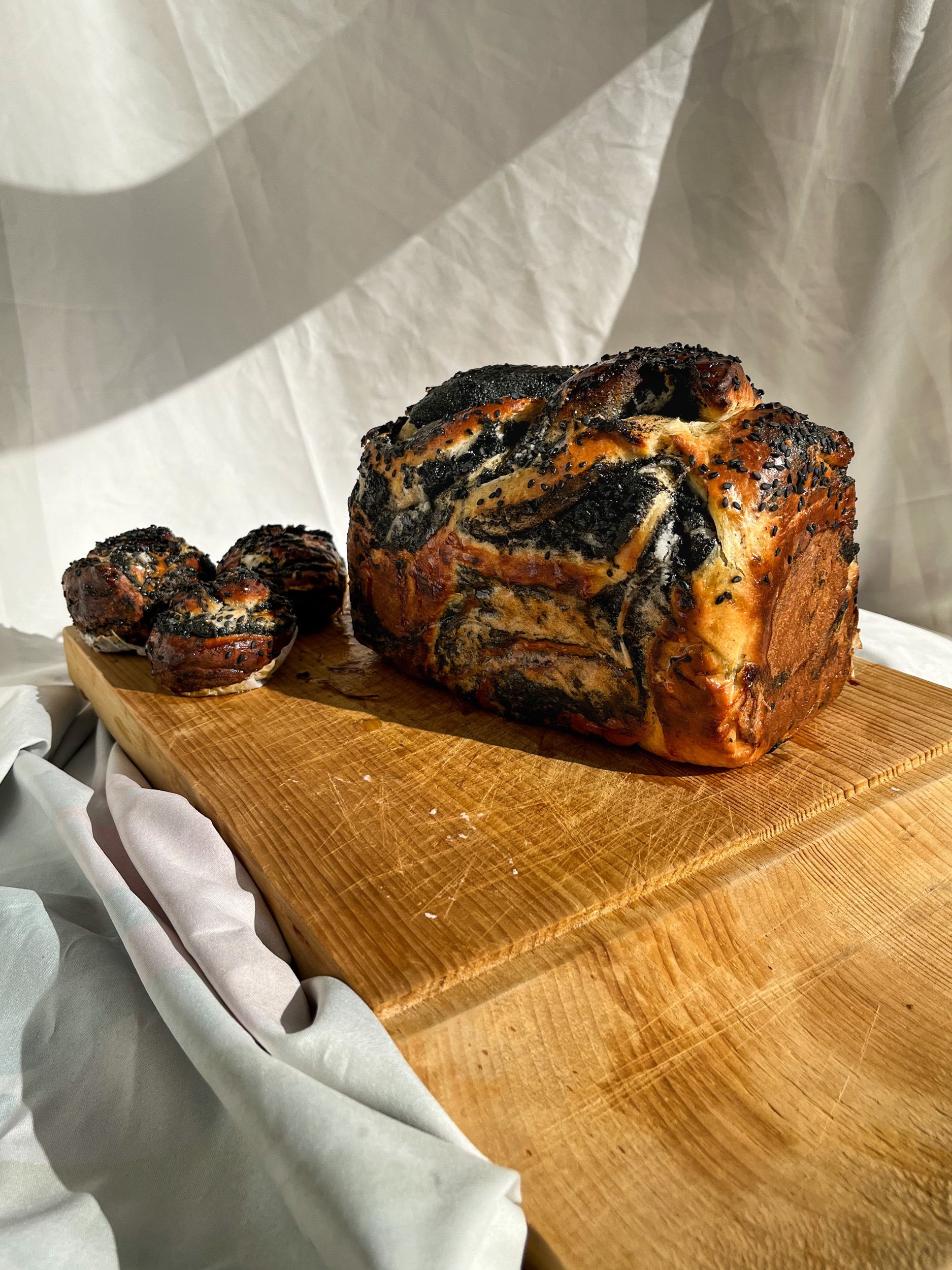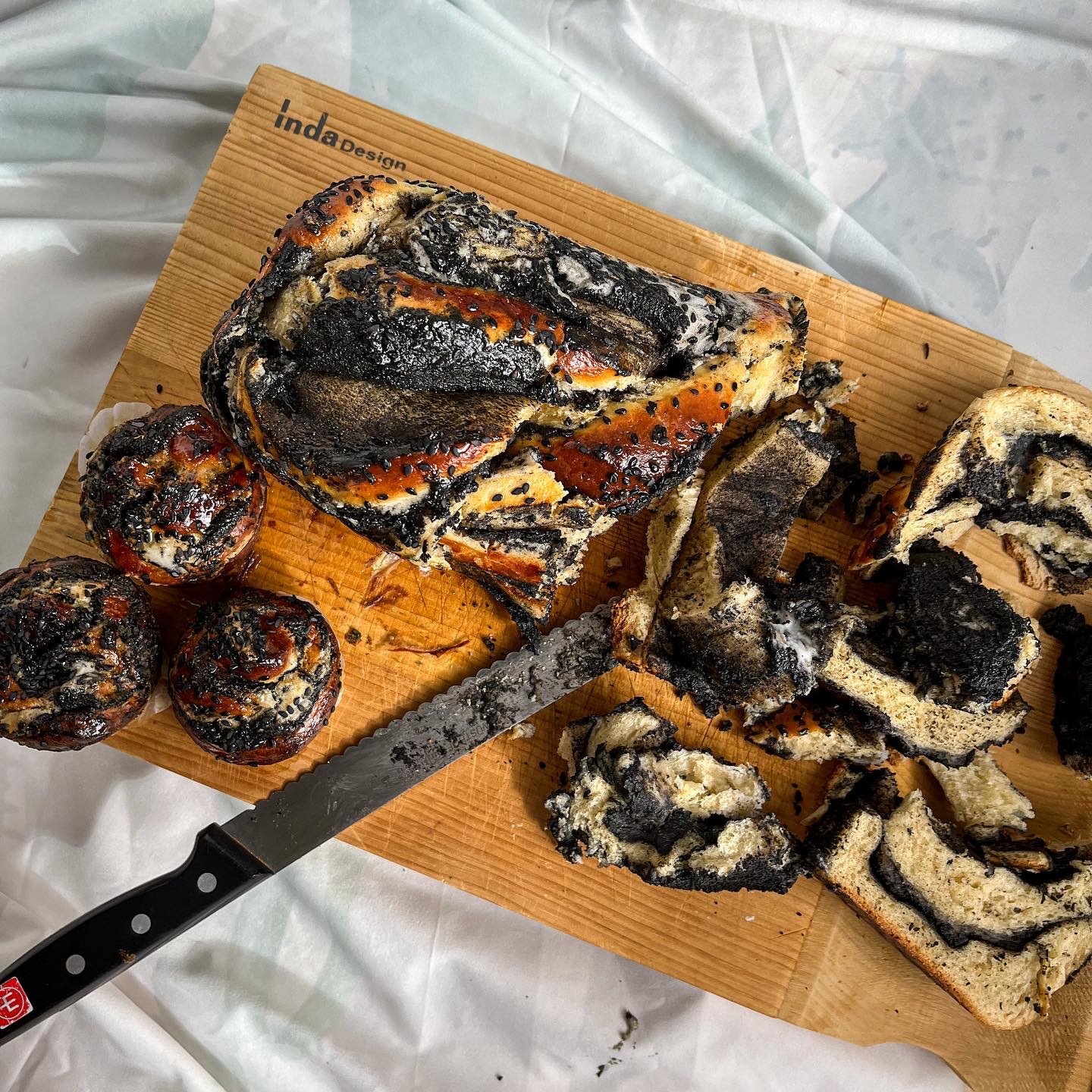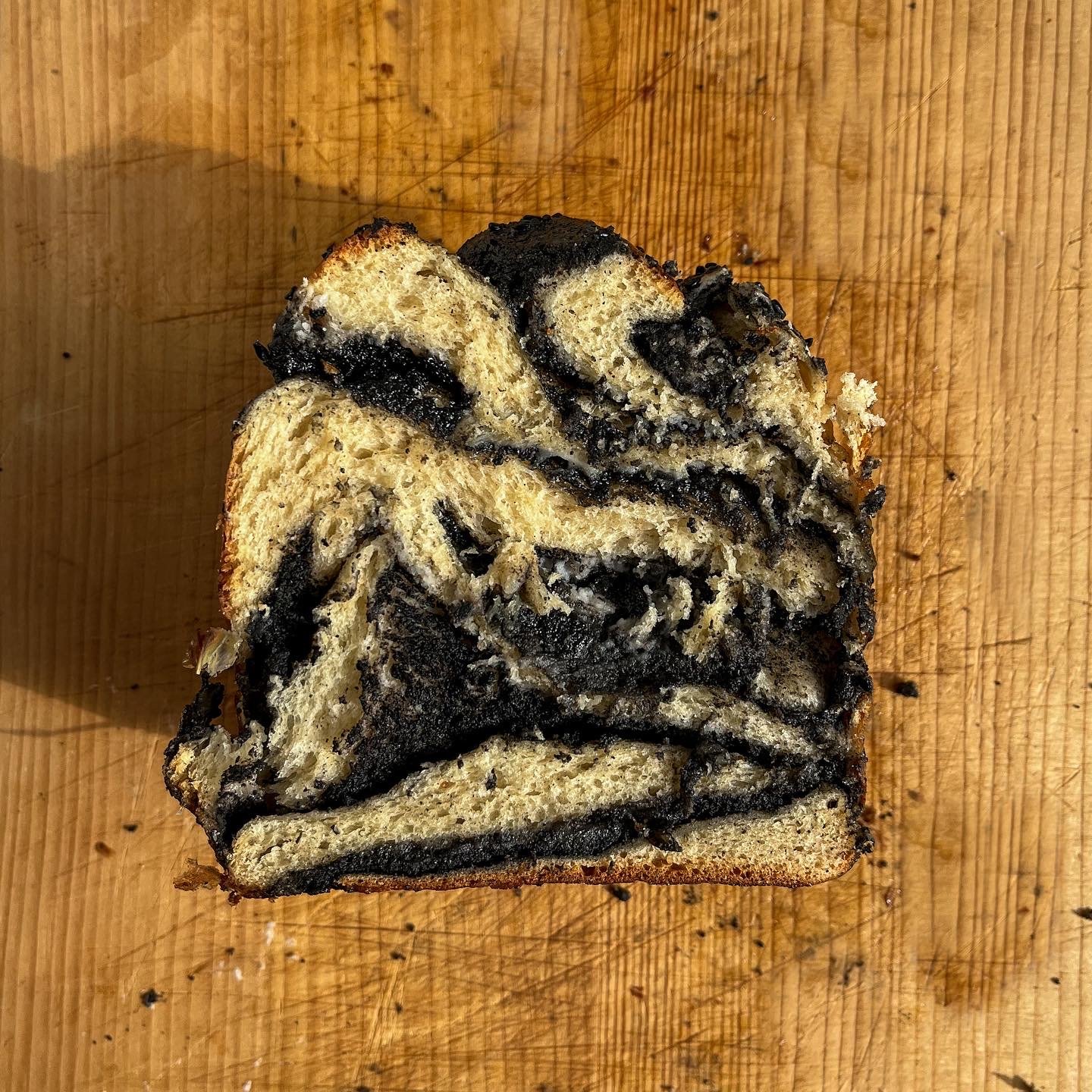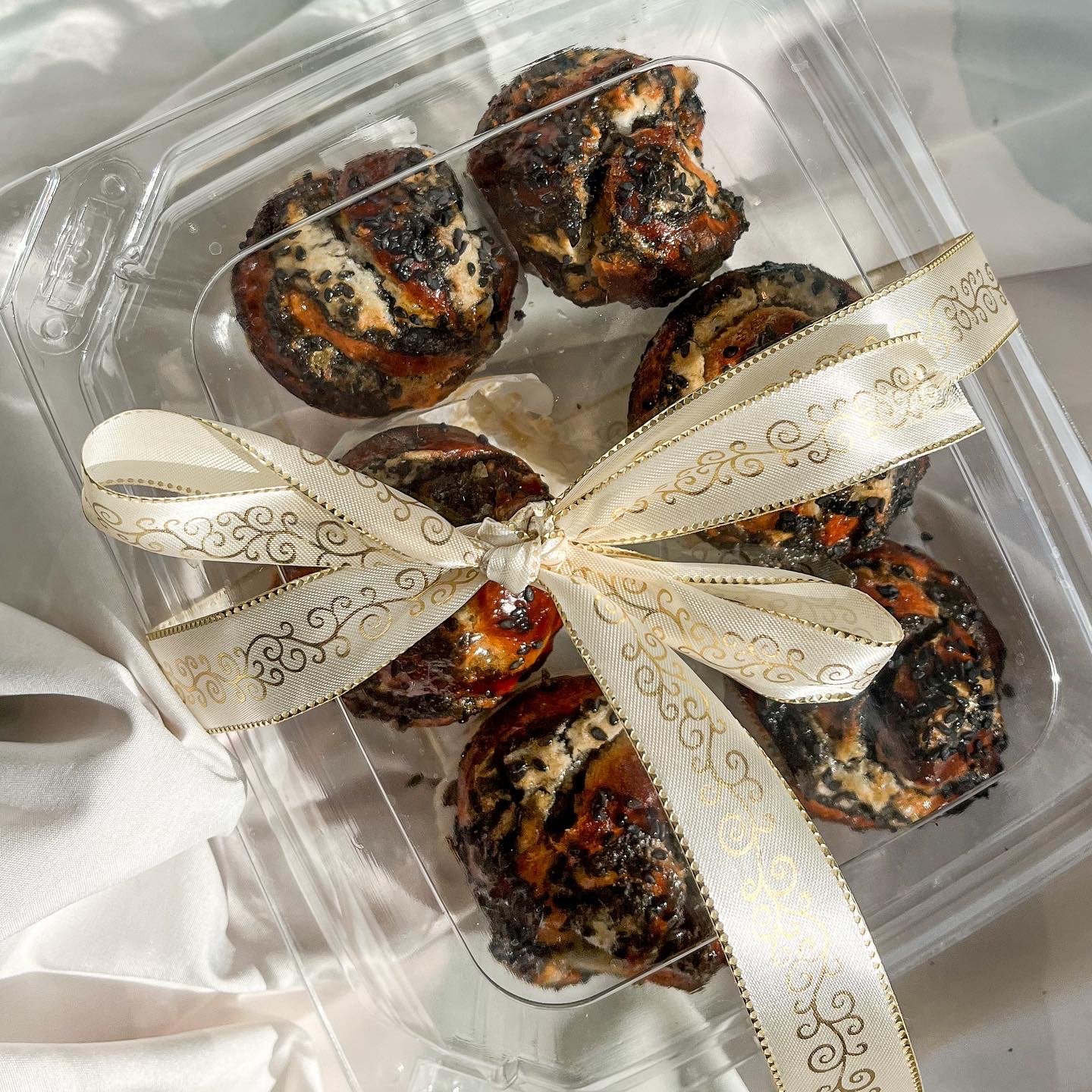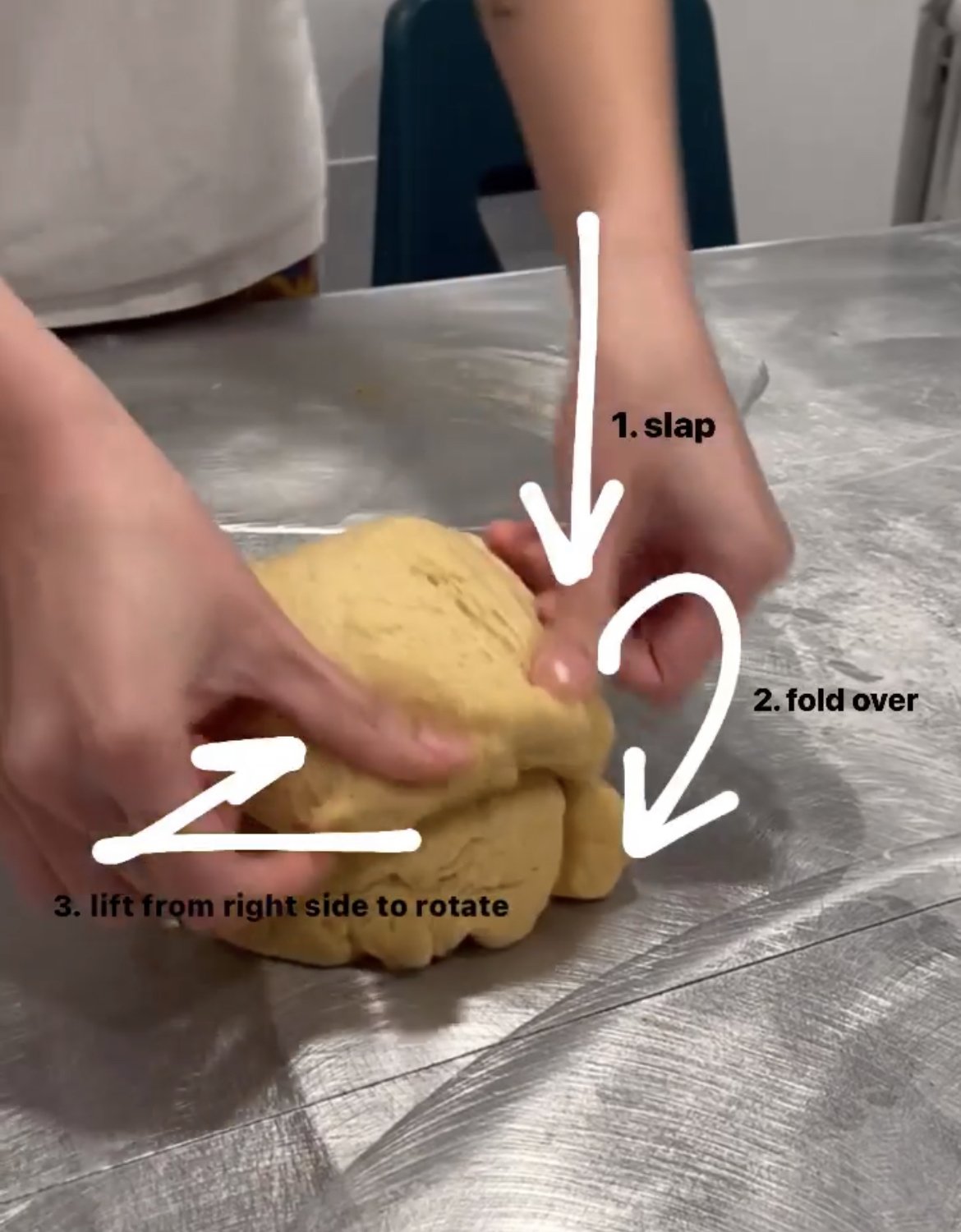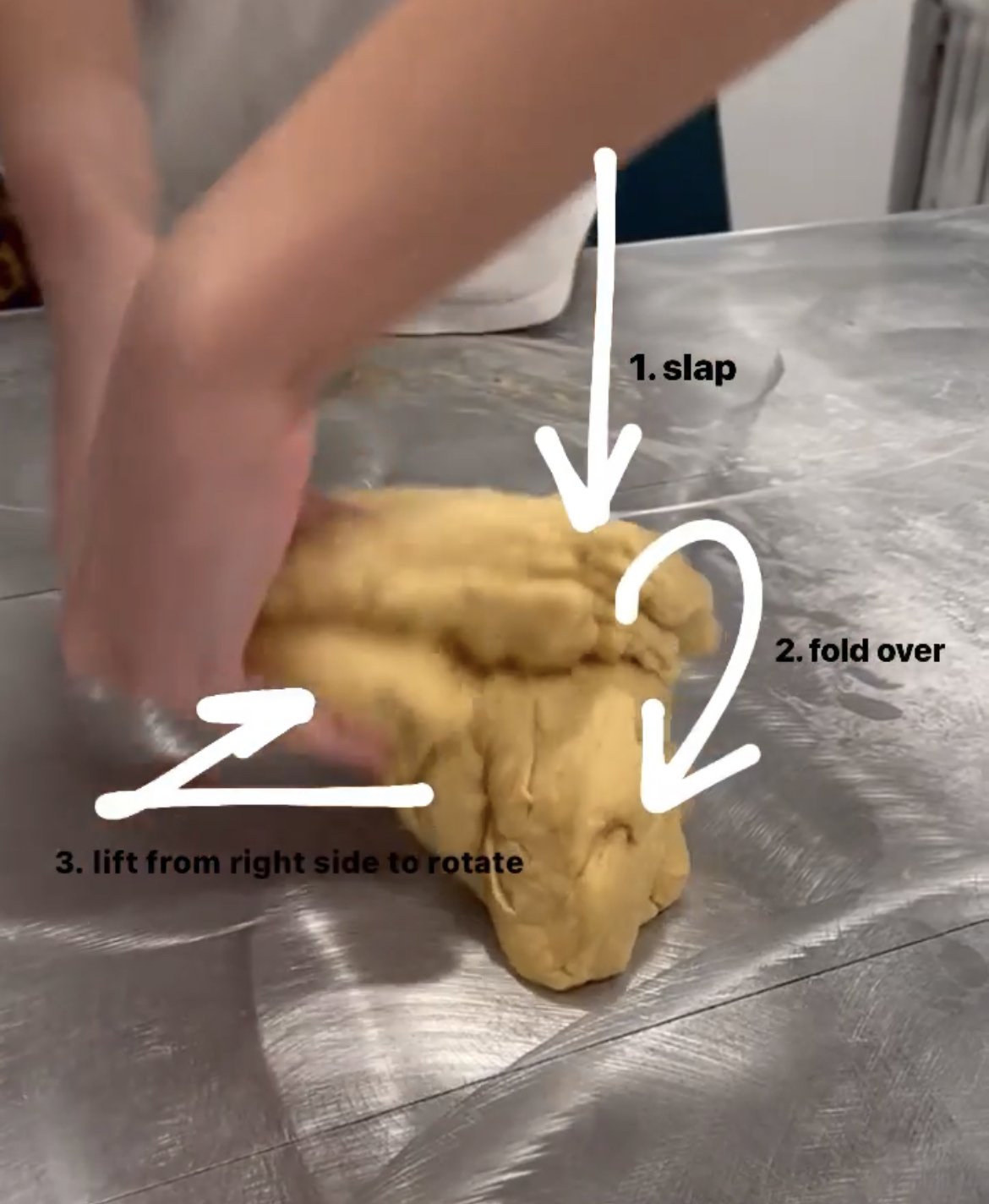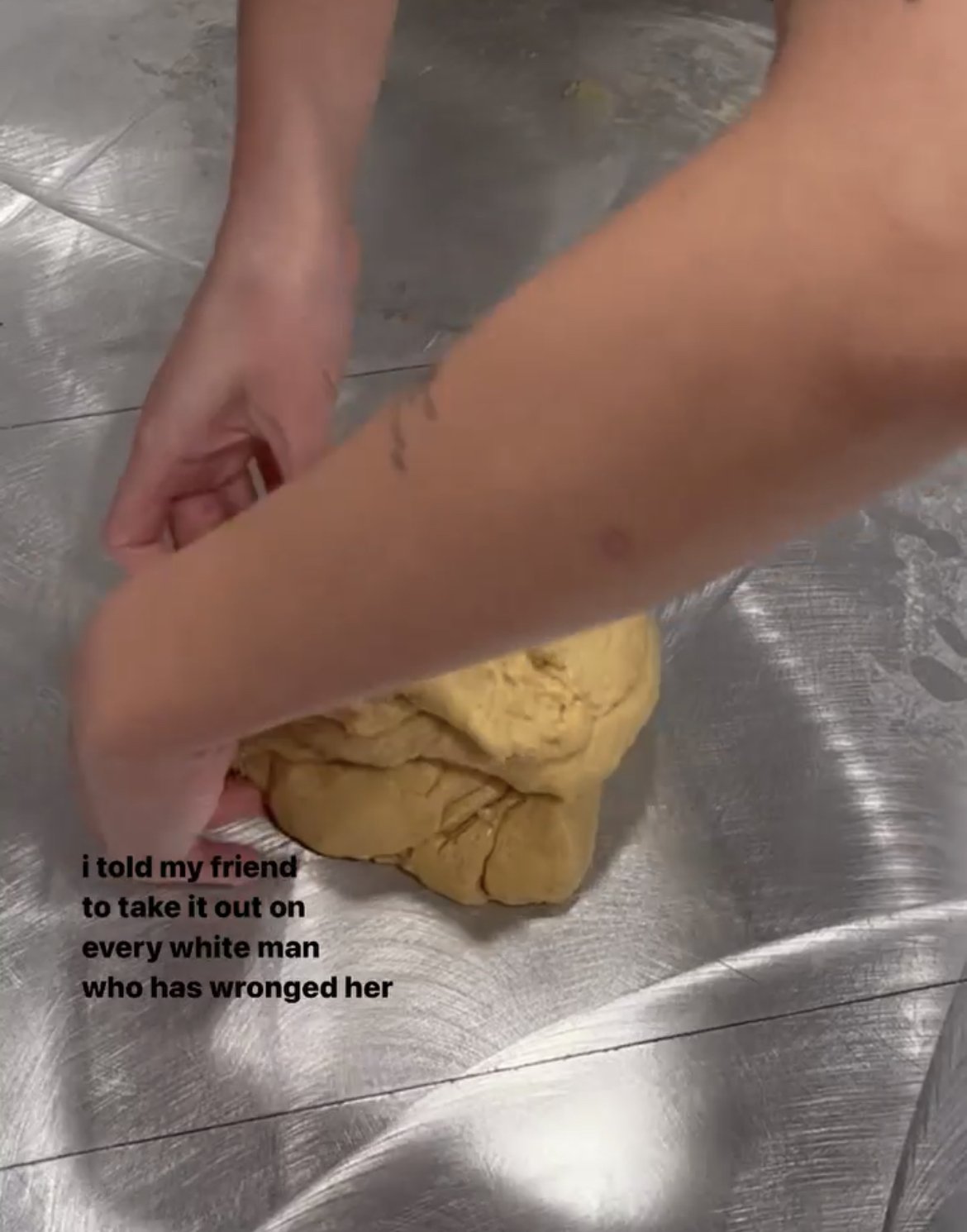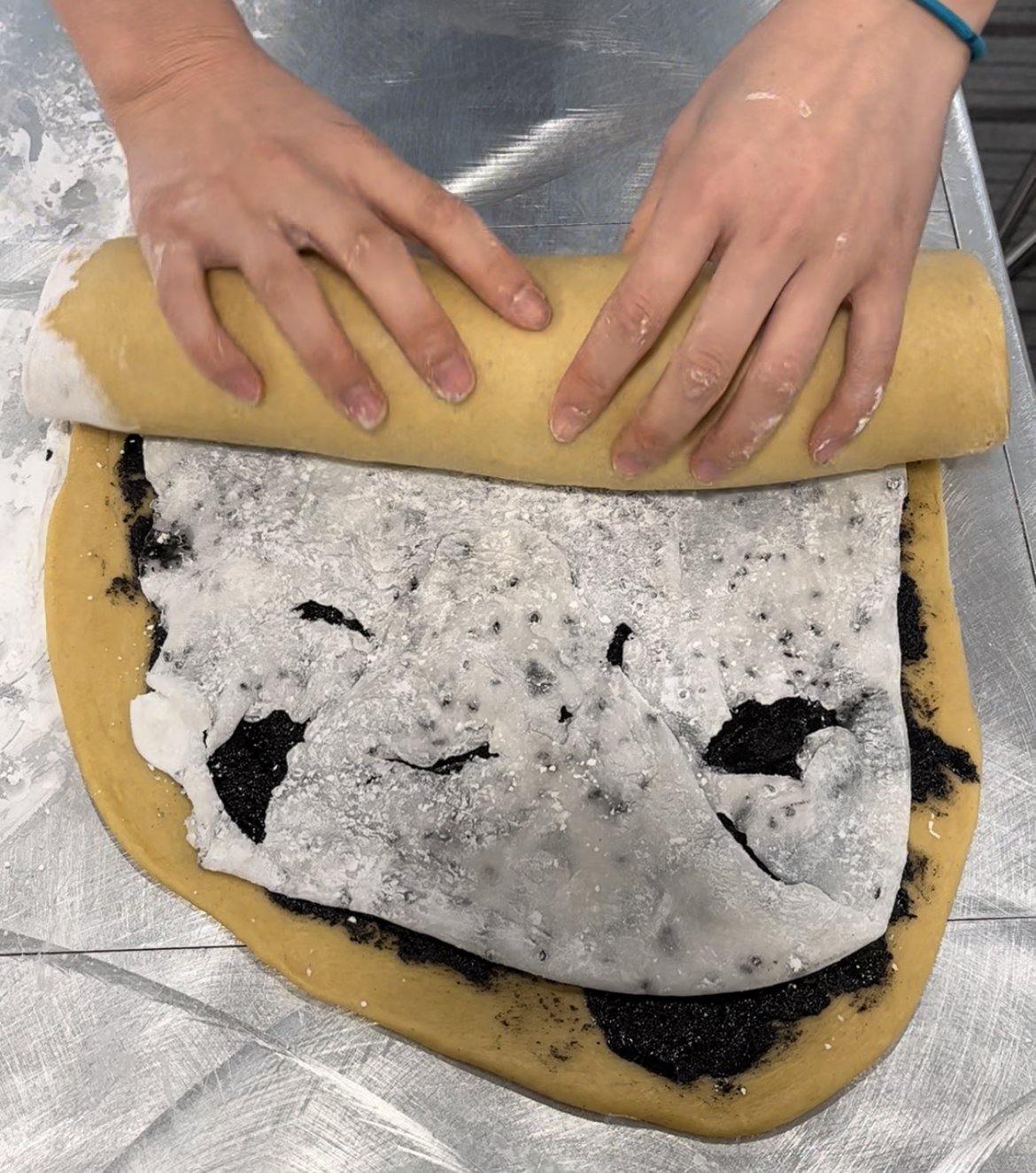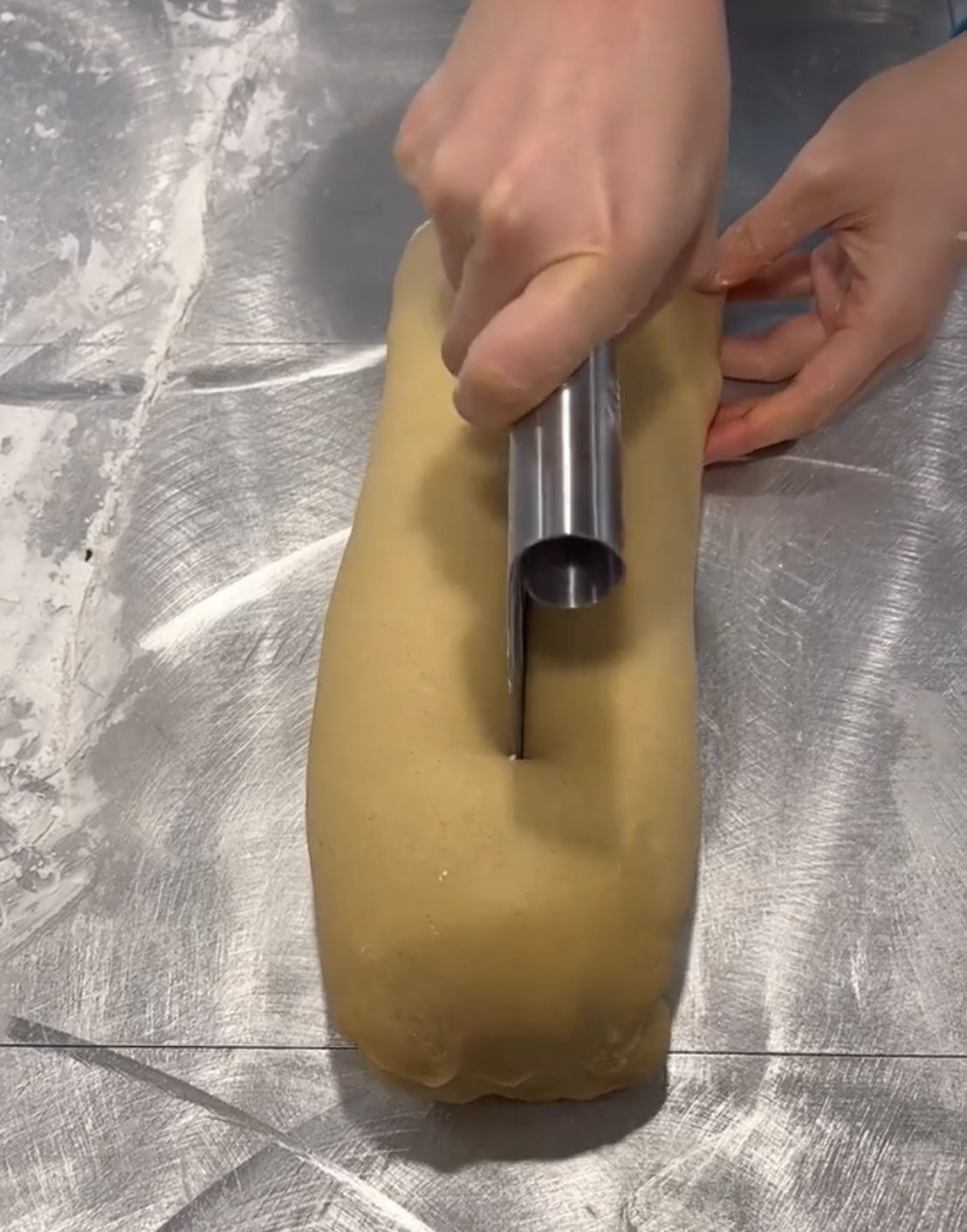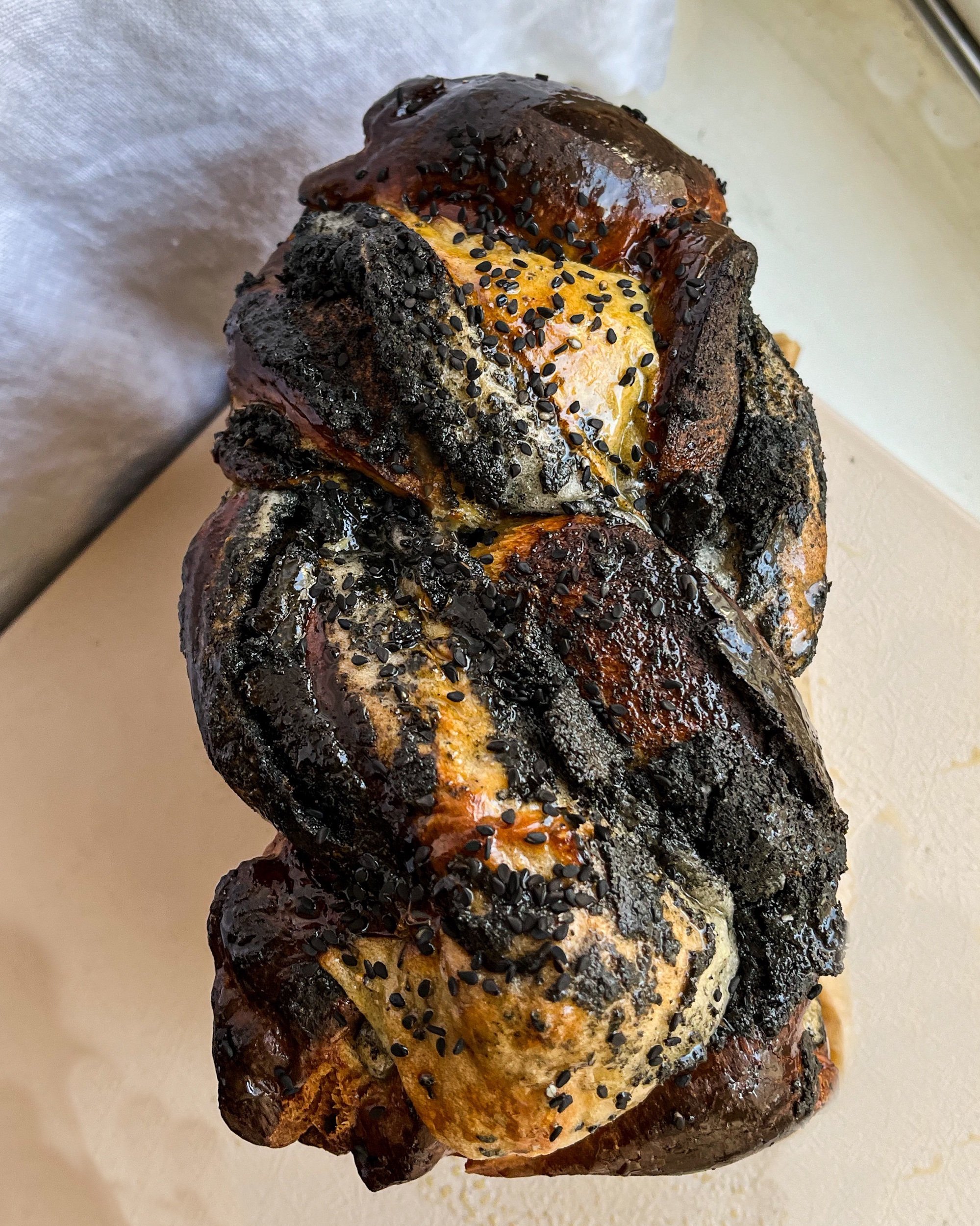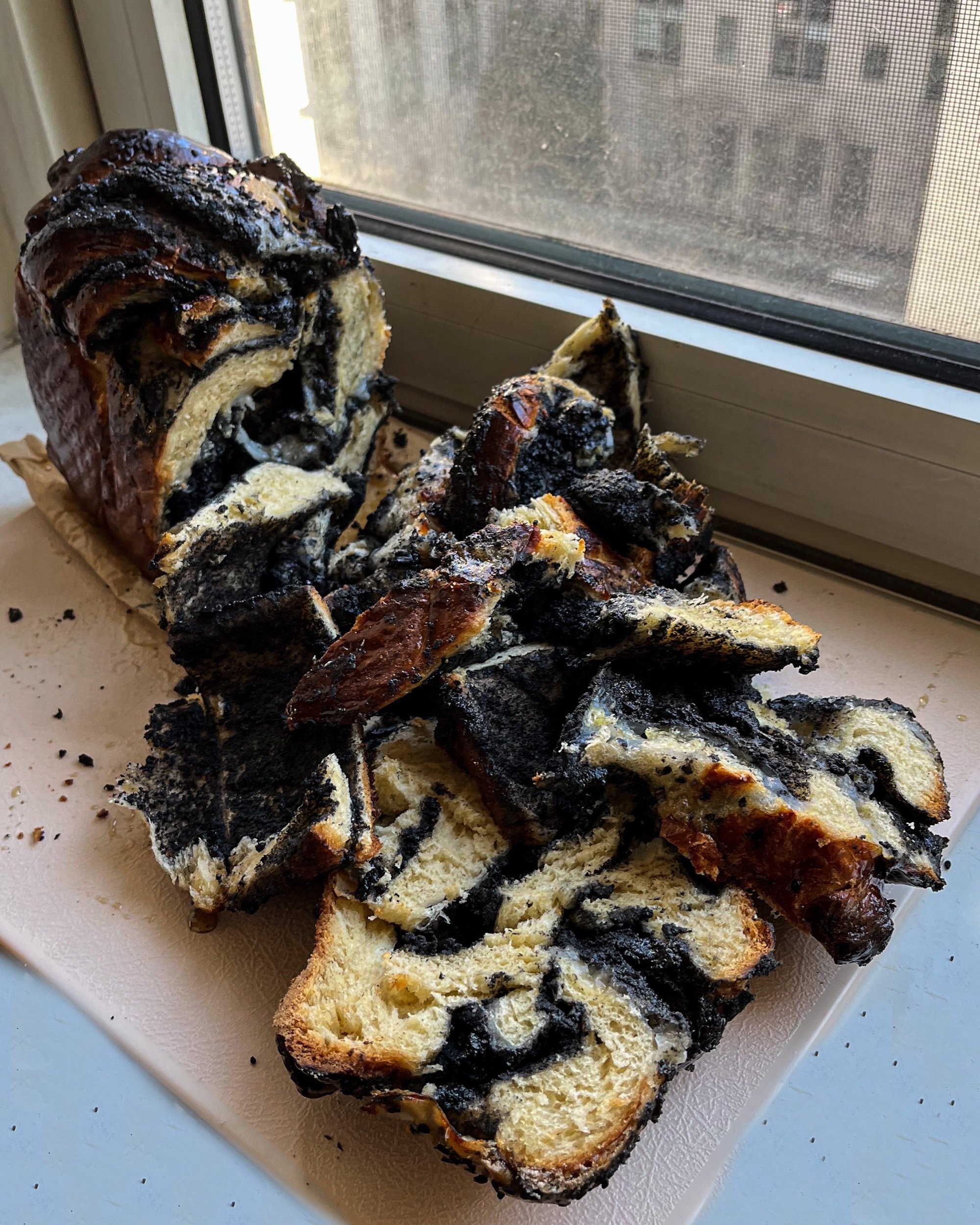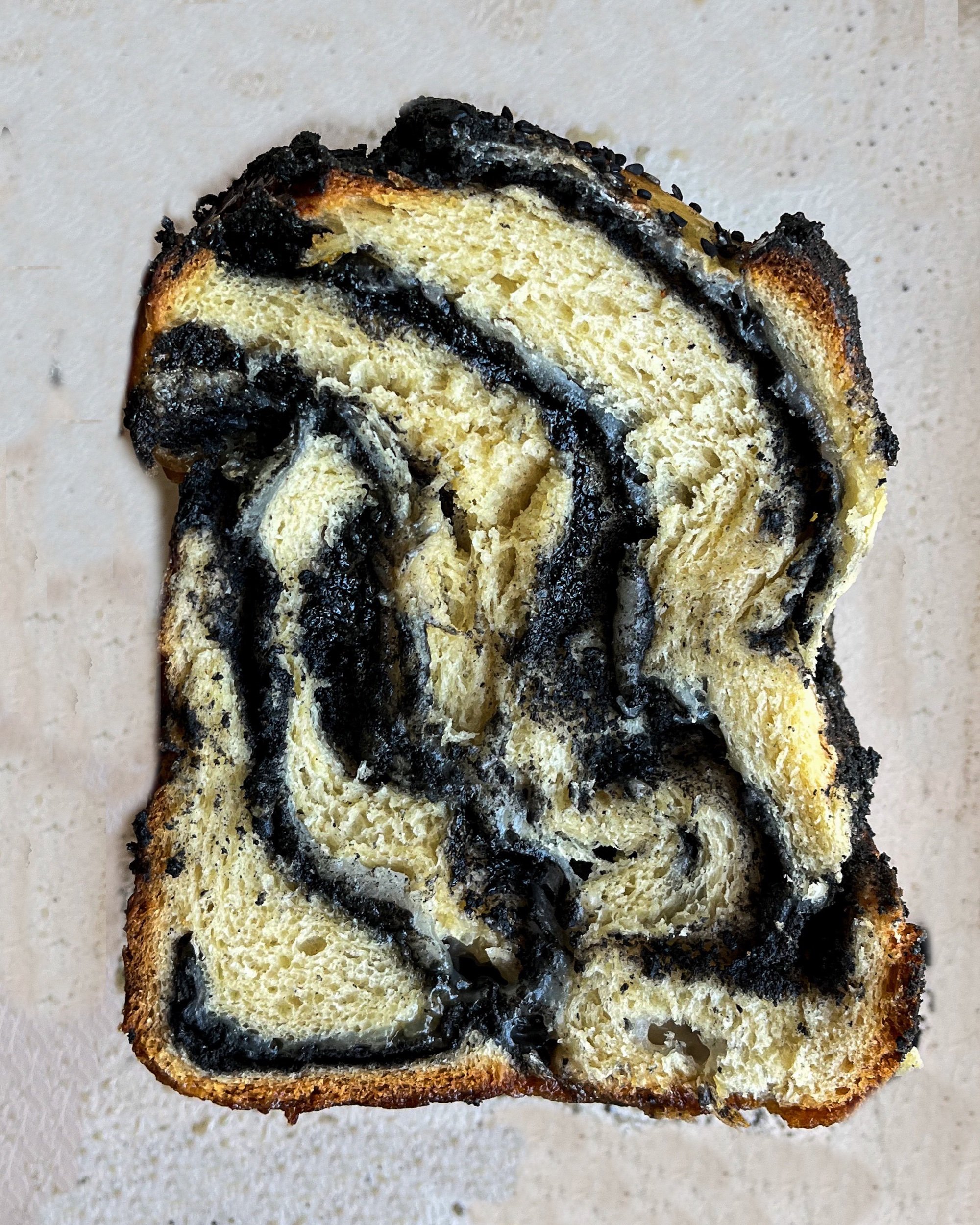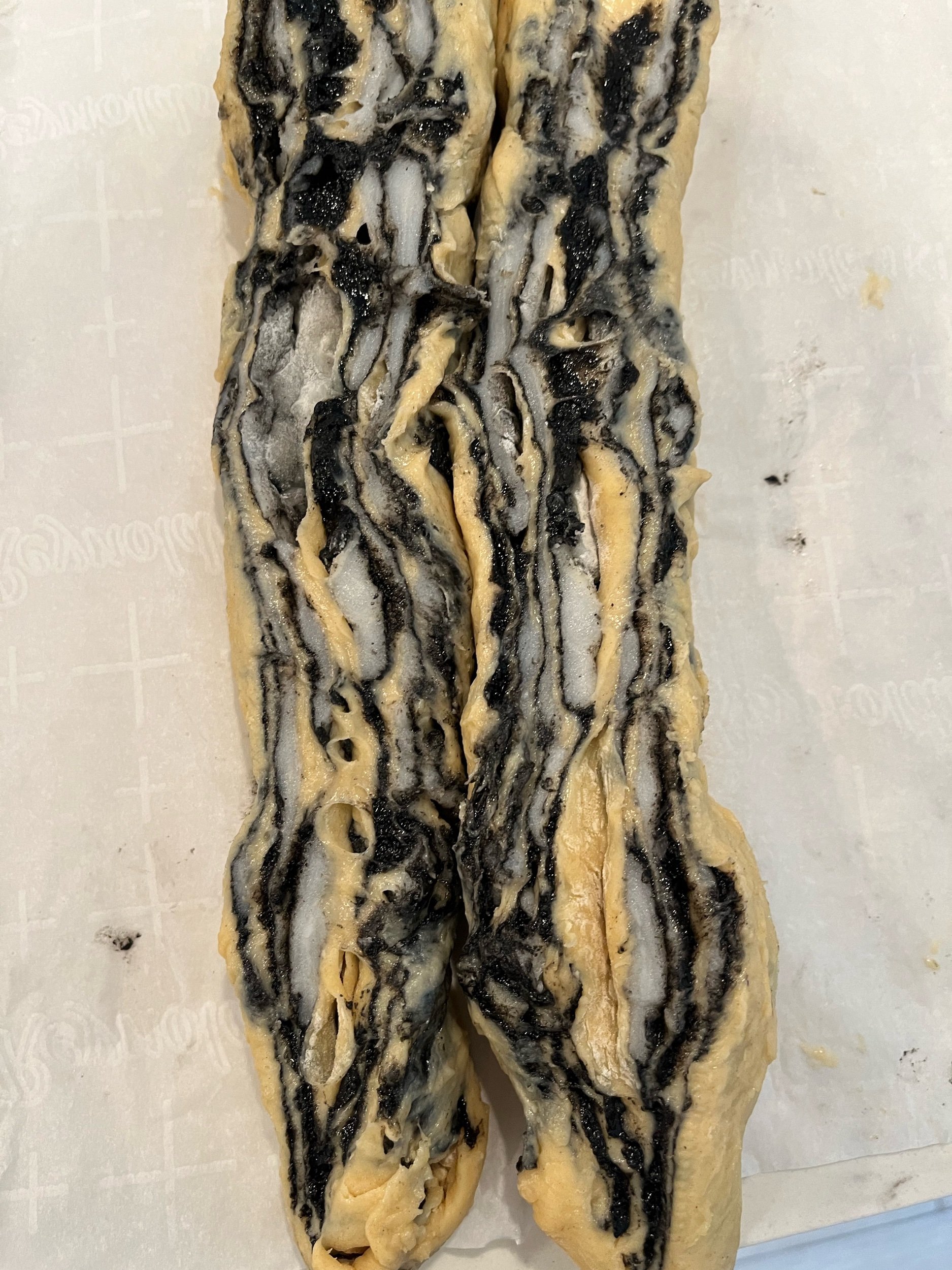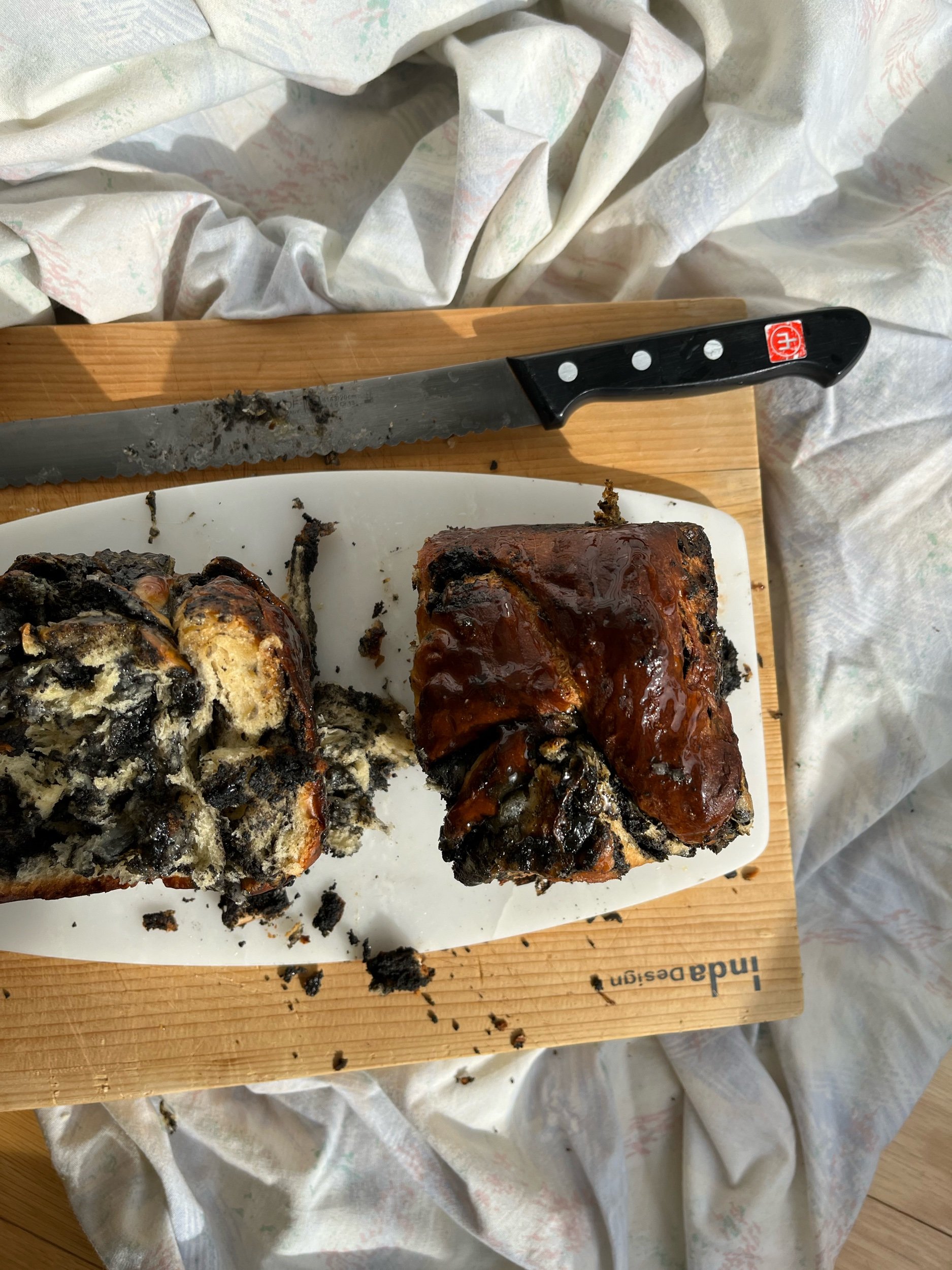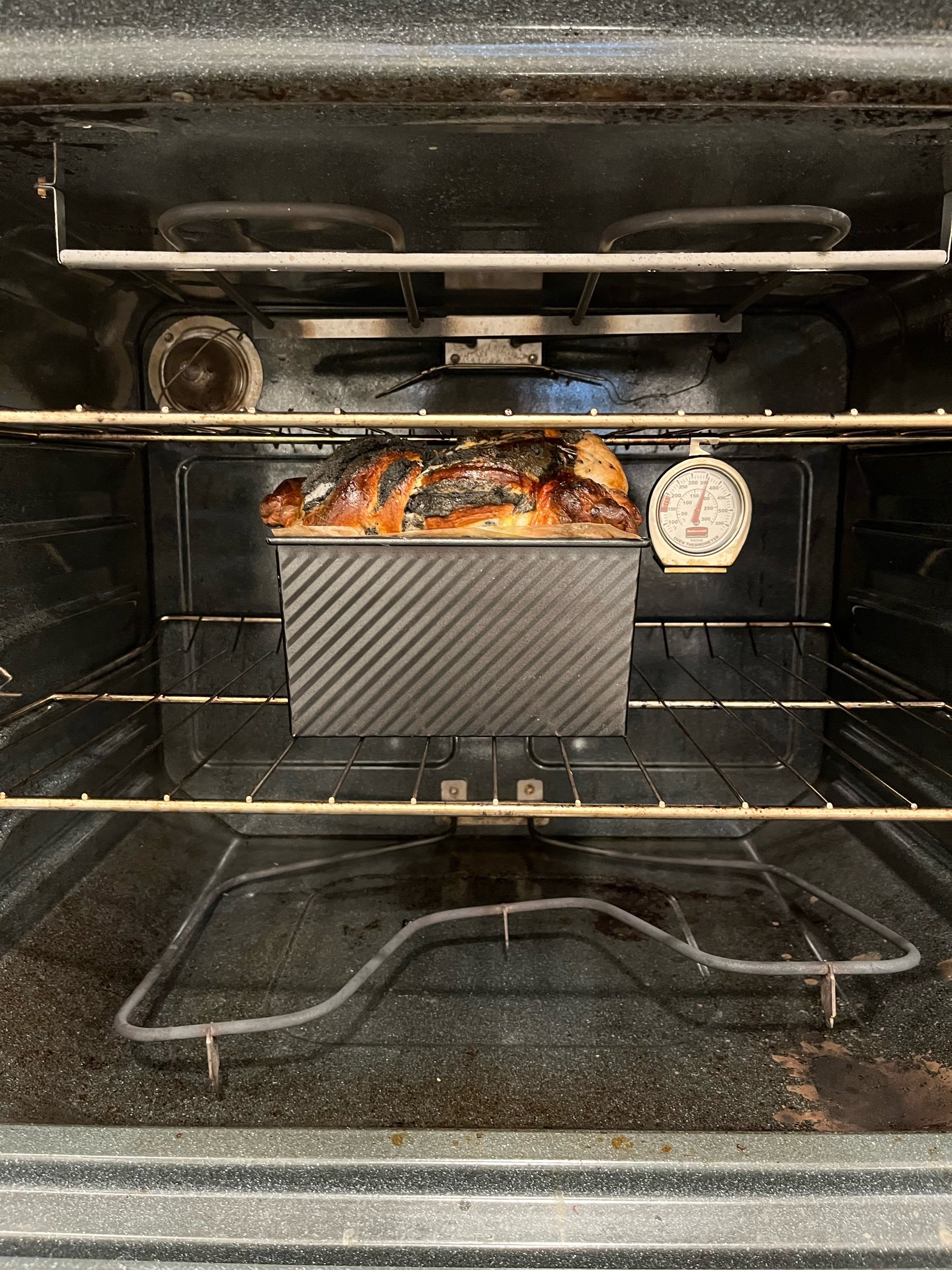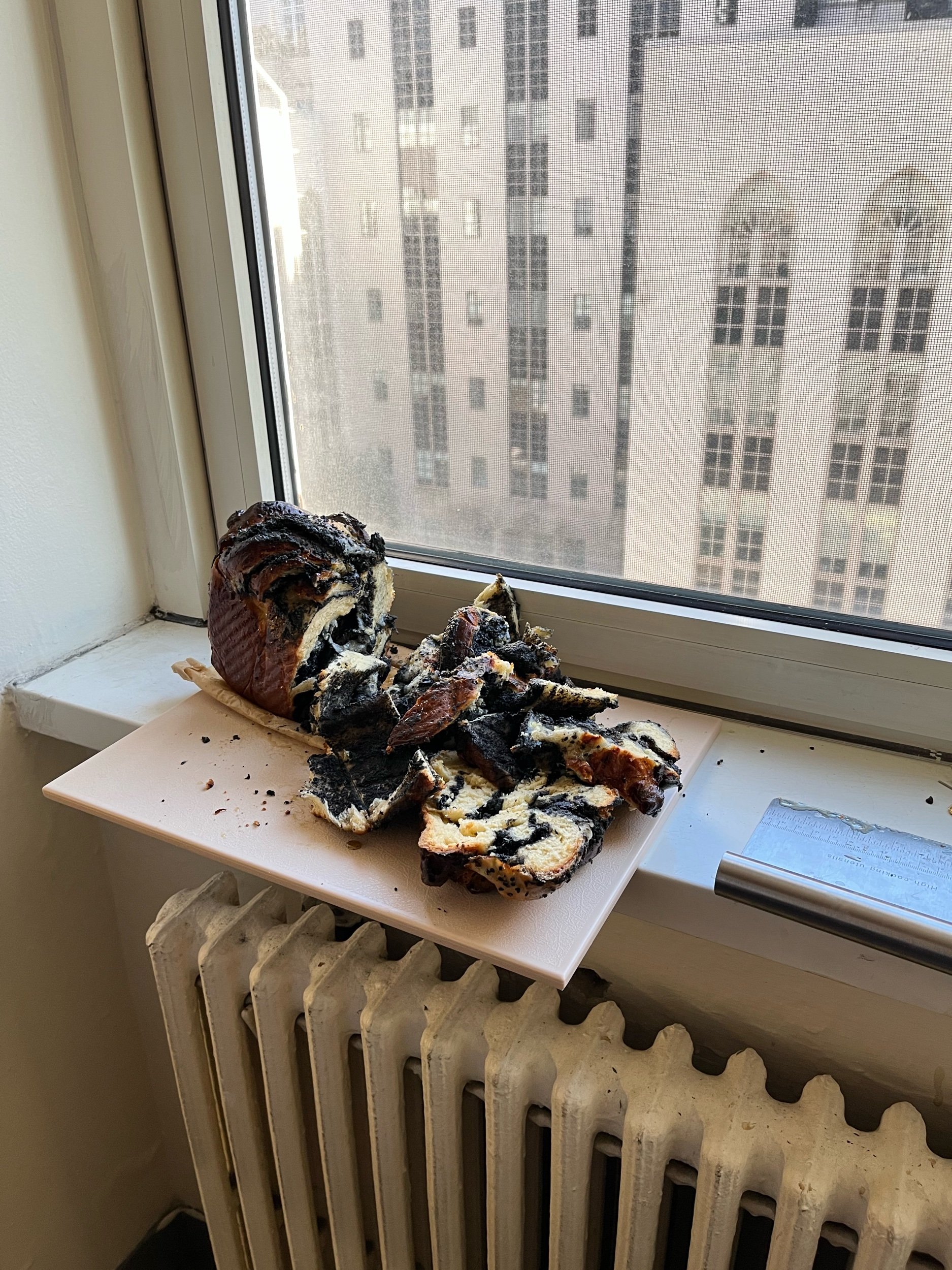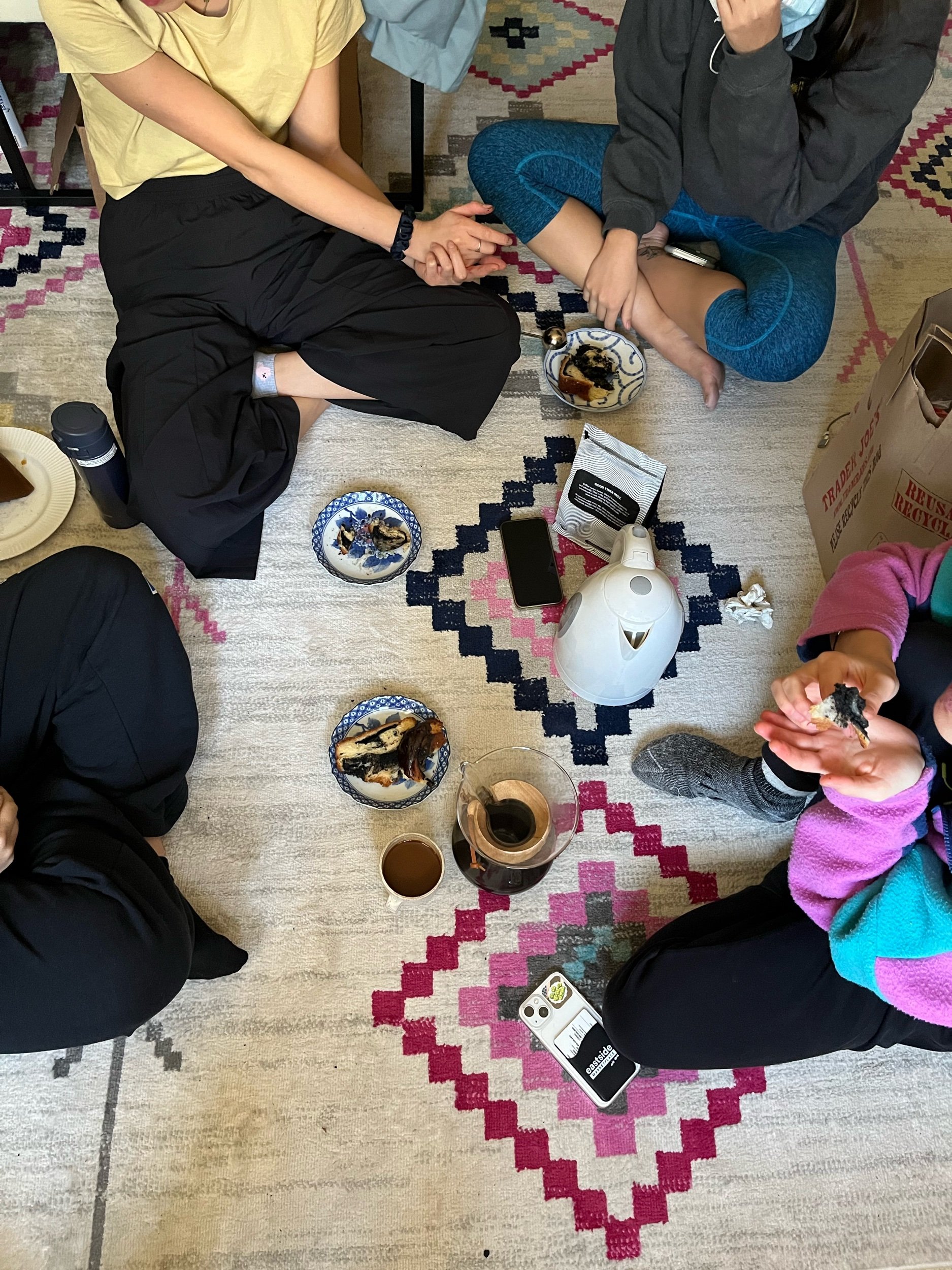black sesame mochi babka
the magnum opus of my breadmaking arc
time: a quiet evening (1.5 hr active time) + the following good morning (3 hrs active time)
servings: 1 tall (9”x4”x6”) loaf
dear friend, i know this recipe looks intimidating. but it only looks so extensive because I hold your hand through it all. i’m including a table of contents, so you can easily read through our process together. -Alex
day 1 ingredients
¼ cup + 2 tbsp 2% dairy milk (= ⅜ cup or 88 ml)
5 g active dry or instant yeast (= 1 ½ tsp)
1 tsp vanilla
3 large eggs, lightly beaten
50g + a pinch sugar (= 1/4 cup + a pinch)
400g AP flour (= 3 ⅓ cup)
1/2 tsp salt
½ tsp cinnamon
1 stick or 8 tablespoons butter (=105g)
*preferably room temp but i always forget to leave it out ahead of time. salted or unsalted, i’ve used both in my development process. it doesn’t matter.
day 2 ingredients
¾-1 cup black sesame paste
⅓ cup white sugar
pinch of salt
1 cup Mochiko glutinous sweet rice flour
1 cup water
⅓ cup sugar
generous heaping of cornstarch
1 egg (for egg wash)
¼-⅓ cup honey
water
black sesame seeds (for sprinkling)
equipment
food scale
whisk or a fork
your hands (see try experimenting with) and a spatula
large bowls
bench scraper
rolling pin or wine bottle
9” x 4” x4” pullman loaf pan
*a pullman loaf pan is different than loaf cake pan. a pullman loaf pan is pan specifically made for loaf bread—most often Japanese milk bread, used to maximize height, giving taller, straighter sides. if you use a loaf cake pan the bread won’t reach the same height, and it will balloon outwards more instead. (also see try experimenting with)
Day 1 recipe:
In a mixing bowl, warm milk to lukewarm, which is technically 105-110 deg. But you don’t have to measure, stick your finger in the milk, and it should feel like warm bath for a baby. Add yeast.
If you are using active dry yeast, add a pinch of sugar, whisk, and wait 5-10 minutes. The surface should be slightly foamy.
If you are using instant yeast, move onto the next step. Don’t worry, it won’t foam.
2. Add eggs and vanilla to yeast-milk mixture. Whisk. This bowl is your “wet bowl.”
3. In a new mixing bowl, add flour, sugar, salt, and cinnamon. Whisk to combine. This bowl is your “dry bowl.”
4. Add half of the wet contents to the the dry bowl. Mix with spatula. Add the other of the wet contents. Mix with spatula. It should look still a little dry. With clean hands, mix the dough in the bowl until no streak of flour are visible.
5. Place the dough onto a clean surface, and begin kneading in a circular motion.
How to knead in a circular motion: Place your right palm on right edge of the dough, and begin to move clockwise. Place your left fingertips on the left edge of dough to continue the motion, that is–catch any excess dough moving outwards radially and move it along with the rest of the dough. This movement mimics a dough hook on a stand mixer.
Practice this movement for 5 minutes. Once you become familiar with the movement, add 1 tbsp butter in the middle of the dough. Take any edge of the dough and fold it over the butter. Knead in a circular motion, until the 1 tbsp butter has been incorporated. Repeat until all butter has been incorporated. This process should take around 15 minutes. As you knead, you will notice that the dough will become more pliable and smoother. Save the butter wrapper.
6. Now, slap and fold for ~15 minutes, or until window pane.
How to slap and fold: In order to slap and fold, the dough first must be smooth.
Pick up the dough from its right side. Slap the dough onto the counter as hard as you can (without letting dough pieces fly into the air). Yes, the slap should be very loud. This is free therapy; take your anger out on any injustice you’ve been doled this week. Feel free to shout specific names. If you have a friend/roommate/partner beside you, ask them how their week was. If you are home alone, FaceTime a friend, turn your camera on, mute yourself, and let them update you on their life while they watch you knead.
What is window pane? Pick up one small golf-size ball of dough. Pull it apart from four corners like a window. As your spread it apart slowly, the dough should not break, and while held up in the air, light should peer through the “window.” The window pane test ensures you’ve built enough gluten into the dough.
7. Rub excess butter from the wrapper on the surface clean bowl. Place dough in bowl. The dough’s walls should not bleed out towards the sides. It should maintain its own integrity. Cover the bowl with a towel, plastic wrap, or shower cap.
8. Turn your oven light on (but do not turn on the heat). Place the covered bowl in the oven. Let the dough rise for 2 hours. It should double in size.
The oven with light on is a makeshift a proofing box at around 80-100 degrees F.
After 2 hours, punch dough down, letting air escape. It should return to its original size. Put the covered bowl in the refrigerator for overnight rest (8-12 hours).
Day 2 recipe:
1. Good morning! Get dressed into your best baker’s uniform, perhaps these are your loosest pants–your linen culottes or the mens’ size M sweatpants you stole years ago. Personally I don a long dress and pull my hair back into a bun at the nape of my neck because this morning I do not live in a big city. I am a young bakers’ apprentice in a town living off a barter economy. Make your morning caffeine, or wait to caffeinate alongside your freshly baked babka.
2. Take bowl out of refrigerator to bring the dough closer to room temperature. The dough should have risen 1.5x overnight.
If your refrigerator runs colder, your dough might have frozen a little and not risen enough. Don’t worry. Set your dough next a space heater or place your dough in the oven with the light on.
Continue with the following two steps–making mochi and black sesame paste–as you wait for the dough to warm a little.
3. To make mochi: combine glutinous sweet rice flour and sugar in a small, microwave-safe, mixing bowl. Add half of the water. Mix with spatula. Add the rest of the water. Mix until thoroughly combined. The mixture should be a white paste. Microwave mochi mixture for 1 minute. Remove from microwave and stir. Return mochi to microwave for 1 more minute. Remove from microwave and stir. Mochi should be almost translucent and stretchy. If it is not almost translucent and stretchy, then microwave for 30 more seconds. Let mochi cool before rolling out.
Generously sprinkle cornstarch on a clean surface. Cornstarch will prevent the mochi from sticking. Coat your rolling pin or wine bottle in cornstarch as well. Roll the mochi into a 8” x 17” rectangle. The 8” dimension is more important than the 17” dimension. Don’t stress if you can’t roll your mochi out that long.
4. To make black sesame paste: combine black sesame paste and sugar. Mix. Try your best not to dip your fingers in it and eat it all.
5. The dough should now be closer to room temperature. Using rolling pin or wine bottle, roll dough into 8” x 17” rectangle. A little more or less is OK.
You want a temperature somewhere between right-out-of-the-fridge and room-temp. If the dough is right-out-of-the-fridge, then you will have a harder time rolling the dough out. If it is room-temp, the dough is harder to roll and pick up with your hands. Does this make sense? It should.
6. Spread black sesame paste evenly right up to the edge of the rolled-out dough. Place mochi rectangle over black sesame. (You might need another set of hands–that is, a friend, partner, family member–to place the mochi nicely. If you find yourself alone, use the rolling pin/wine bottle to transfer the mochi: loosely roll the mochi around your rolling pin/wine bottle, lift onto dough, and then unroll the mochi from the rolling pin/wine bottle.)
7. Cut a piece of parchment paper with “wings.”
What Alex? You want a piece of parchment that has “wings” hanging over the long side of the pan. You will use these wings to lift the bread into and out of the pan. If my pan is 9” x 4” x 4”, then I want to cut a piece of paper 9” x ~16”: 4 (width) + 4 (height of R wall) + 4 (height of L wall) + 2 (overhanging R wing) + 2 (overhanging L wing) = 16. Don’t worry you don’t have to do math. I just wrote out the math, so you could understand. Just eyeball it.
Pick up the 9” end, and roll the dough as tightly as possible. At this point, now pick up the rolled dough and transfer onto the middle of the parchment paper.
If your kitchen runs warm and you notice the dough has become more pliable/less easier to handle, place the dough in freezer for at least 10 minutes. Freezing the dough slightly will make it easier to handle in the following step.
If your kitchen is cold, continue to the next step.
8. Using a bench scraper or pair of scissors, slice/cut the dough lengthwise down the middle. Admire the layers. Take a picture even.
9. Carefully and tightly as possible twist the two halves with the cut edge facing up. At this point, your dough should match the length of your pan. If not, tuck one edge around.
10. Holding parchment “wings,” lift dough into pan. Cover and place pan in oven with light on. Do not turn the heat on. You are using the oven as a proofing box. Wait 1-1.5 hours for dough to rise. The dough should have risen 1.25-1.5x.
11. At either 1ish or 1.5ish hour mark (it doesn’t matter), take the pan out of the oven. Now preheat the oven to 350-375 deg F. While you wait to preheat, beat 1 egg, and generous brush an egg wash over the top of the dough. I say “generous” because what are you gonna do with the extra egg wash? You might as well just use as much of the egg as you can.
It is OK if you don’t own a pastry brush. I don’t. I just use a fork or my fingers.
12. Bake bread for 40-45 minutes.
13. To make burnt honey: While the bread is baking, in a small, heavy-bottomed pot, add ¼-⅓ cup honey (however much it takes to cover the bottom of your pot). Heat on medium-low, bringing honey to simmer (~5-10 minutes). Once honey is simmering, every couple minutes or so, move the pot in a circular motion to swirl the honey. Honey should begin to sputter and bubble. Once you see smoke arise from the honey, add 1 tbsp water. The honey will expand–it might look a little scary, but just swirl the pot. Turn off the heat, but leave it on the warm burner until ready to glaze.
The burnt honey will thicken and “candy” or go hard as it cools. If it becomes too viscous, gently reheat on low until it liquifies.
If you are tired, then feel free to skip the burnt honey: just make the glaze with regular honey. But don’t skip the glaze overall!
14. Once fully baked, the top should be golden brown. Using parchment “wings,” lift bread out of the pan.
If you have a roasting thermometer, you can measure the internal temperature of the dough right after you pull out of the oven. If fully cooked, the bread should reach an internal temperature around 180-200 deg F.
No thermometer? Stick a chopstick in the bread and show me your best pull out game. You will see mochi (more translucent) on the chopstick, but you should not see raw dough (which is more yellow in color). You can also knock on the side of the bread: it should sound hollow. Honestly though, my babka in all three tests were cooked through: I wouldn’t worry.
15. While the bread cools, add ~2 tbsp of burnt honey and ~1 tbsp of water to a small bowl. You can eyeball this. Pour the burnt honey glaze on top of the bread. Make sure to coat the babka evenly and coat crevices too. If you have additional glaze, brush it down the sides as well. The glaze will harden.
16. Take some deep breaths, be patient, and wait for babka to cool completely. The crumb will continue to develop as it cools, and it will be easier to cut.
Voila–black sesame mochi babka.
Babka is best enjoyed on day one. On subsequent days, lightly toast babka to warm up.
Non-negotiables
Mochiko glutinous rice flour – No, you cannot substitute for regular rice flour/brown rice flour. It is not the same.
Glaze – The glaze adds shine and crunch to the crust. It also adds an additional, needed sweetness. There’s really not an extravagant amount of sugar in the actual bread. If you’re tired, feel free to skip making the burnt honey. But don’t skip the glaze overall. (The burnt honey will add a more rich and caramel-like flavor.)
Try experimenting with
Can I make this vegan or non-dairy? – I’m not stopping you, but it’s not going to taste the same and probably won’t achieve the same height. If you do, I would try to preserve the fat content in your non-dairy choices as much as possible.
Black sesame paste – I’ve found black sesame paste at H Mart and other asian grocery stores. It’s less expensive than you would think too, only ~$5 jar. If you can’t find the black sesame paste, you can ground black sesame seeds in a food processor and high-speed blender until smooth. I’m not sure on the measurements, so you’ll have to experiment.
Stand mixer – I’ve intentionally developed this recipe to be hand kneaded. I dislike when recipes only provide instructions for stand mixer. It’s frankly rude. Do you just expect me to own a $500 kitchen appliance…when my hands will do just fine? I’ve always hand kneaded my bread, and I don’t plan on stopping anytime soon. There’s a therapeutic quality to feeling the gluten develop underneath your fingers and then pulling apart that same bread once baked. Like yeah, you did that.
Nevertheless, would my life be 10x easier with a stand mixer? Yes. Would be life be 10x less romantic? Yes. But based off some other recipes, I’m estimating it should take 8-10 minutes to incorporate the butter fully and reach window pane with a stand mixer.
Burnt Honey – Yes, I know this recipe makes four times the amount of burnt honey that you will need for the bread. Store the burnt honey in a air-tight container, and reheat in the microwave for 15 seconds to melt down into a less viscous consistency. Put a tsp in your tea or coffee. Drizzle on top of your toast or on your apple. Or wait….until my next recipe drop:.... Burnt honey cinnamon matcha latte…incoming.
Rolls! Buns! Wreath! Lil loaves! – The recipe can also be tailored toward a variety of pans. Instead of cuttting the roll down the middle (day 2, step 8), cut the roll in 1” inch slices–as you would with cinnamon rolls. Arrange the rolls in a cake pan or muffin tin. Then either I tried this in test #1, and it worked perfectly. Perhaps bake for 5 minutes less. You could also change the dimensions from 9x17 (day 2, step 5) into a longer, skinnier rectangle, and roll and twist the dough into a wreath. If you own mini loaf pans, figure out the math, and you could also make mini babkas!
Food styling tips
Harsh, direct, natural light – The golden crust and glaze reflects sunlight so beautiful. Look at the difference between harsh, direct and indirect lighting.
Waiting for the bread to cool and bread knife – The crumb/layers will not be fully distinct if the babka has not completely cooled. The serrated knife edge will cut cleaner slices.
Slice shot – Filming the drop of the first slice will require an extra hand or two. The shot below required four people total. Slices toward the middle of the bread will have a thicker and more defined swirl.
Pull shot – Take one slice and pull apart the middle to see the bread break and mochi streeettch. Maybe you’ll even capture some of the steam escaping.
Angles! Angles! Angles! – Flatlay, straight-on, macro, from afar! She has no bad side.
Recipe Development
Test #1 - Mochi donuts have been the newest dessert craze between NYC and LA. I can attest: it’s worth it. It’s more than just fried dough: the glazed crust and bouncy interior is phenomenal sensory experience–and one quite intimidating to mimic at home.
What does Alex do when she is set up with almost unthinkable challenge? She I wanted recreate the bready mochi texture but instead into a babka. Babka traditionally is a Jewish sweet bread, shared around high holidays It’s made from an enriched dough with lots of eggs, milk, and butter, swirled with a chocolate layer, topped with sweet syrup, streusel or both, and baked for a tortuous hour. Each kitchen of the Jewish diaspora adds a twist to the bread, whether in the dough or filling. I didn’t grow up eating babka, but I’ve always seen it in bakeries and friends’ home–dying to try a piece. It speaks simple indulgence, much like rice cakes do in Asian cultures.
I came home for the holiday season, inspired to marry the two desserts. Initially, I wanted to incorporate the mochi into the dough as they do in mochi donuts. I spent research pretty extensively online to see if anyone has tried this before. I didn’t. However, I found one black sesame tangzhong babka recipe by Betty Liu, food blogger and author of My Shanghainese. Tangzhong is a Chinese technique, in which a small portion of the dough is cooked gently over the stove to create a softer, pull-apart texture in milk bread. I was intrigued as this chewy, pull-apart texture was what I was trying to mimic with the mochi.
But whenever I feel myself getting too ambitious, I consult my Libra-sun, Jewish-Mexican, best food friend Rachel, @xoxo.glutengirl, and ask her if I’m going in over my head. Rachel recommended against tangzhong. She thought a tangzhong would be interesting, but babka are not stringy like milk bread and instead more bouncy. I heeded her advice and her favorite recipes. She directed me towards Lion’s Bread, who riffs off an Ottolenghi recipe, and Jake Cohen’s recipes. I don’t trust any baking recipe that only gives me volume measurements, which are very imprecise for baking. I need weighted measurements, and Lion’s Bread only gives volume. Both had the thinnest swirl of chocolate I had ever seen. Perhaps that is how the babka is traditionally made, but if I’m having mix-ins with bread, I want to maximize the ratio of filling:bread. Cohen then referred to Melissa Clark as Jewish Queen, and so I then went to my bible, NYT Cooking, and looked at Clark’s recipe.
In my first test, I followed Clark’s dough measurements, and I excluded her filling, syrup and streusel. I incorporated the mochi as a separate swirl rolled in the dough as well, not mixed into the actual dough. Initially, I was worried that the mochi wouldn’t cook, but I saw a Filipino food blogger Lito Supply incorporate mochi as a separate layer in their twisted ube bread. I didn’t realize that all babka recipes technically makes two loaves until more than halfway through the recipe....at which point I decided just to use all the dough to make one tall boy. The mix-match of recipes yielded phenomenal results. Her recipe ended up turning into one tall boy and six small rolls. I gifted the six small rolls to a family friend.
What I did right — i am woman, i am fearless, i am sexy, i am divine, i read 7 different recipes, pick and choose which steps I like, and then wing it 👼🏼
I was worried the bread might not rise as tall because of my hand kneading and the filling was so heavy. Heavier fillings require stronger gluten bonds to capture the CO2 to lift them up. But the bread rose incredibly high! The texture was just as I had idealized–somewhere between stretchy mochi and a bouncy enriched bread. The black sesame filling was so thick. Honey glaze added the final nuance of sweetness.
Needs improvement — I didn’t cook the mochi before spreading it onto the bread, so instead of remaining a distinct layer, it bled into the bread. I need to scale down the recipe from Clark’s dough measurements to make just one loaf, not one loaf + six rolls.
Test #2 — This recipe was only supposed to be a one-off–something I make once, just for the chase, just to conquer it. But I received an emphatic response on IG to develop it. I couldn’t believe that you would trust me to develop a bread recipe for you. While I do bake, I’ve never considered myself a baker. To me, a real baker must know all sorts of batter recipes from scratch, and I would have no idea how to make cookies without a recipe. Two years ago, I had never made bread before. However, once I started baking bread in 2020, I couldn’t stop. Over the past two years, I’ve realized I’ve learned an entirely new language, and bread has the baked good that has become an extremely iterative and therapeutic process for me. Perhaps developing a bread recipe could be a rewarding product of my baking journey. (I studied English, what can I say, I love narrative closure.)
I baked the second loaf the night before I left LA to bring back to friends in NYC. Don’t bake bread the night before a flight and an exam later in the week. I cut Clark’s dough measurement’s by 25%; however, I must have been measured something wrong because the dough was too wet. It was flying everywhere as I kneaded. In test #1, I took 30 minutes to reach window pane. In test #2, by the end of an hour, the dough barely held its own integrity. Regardless, I trudged on. I didn’t have any expectations for this test, but at this point, I had already used so many ingredients that it would be a waste to throw out.
What I did learned – TSA will not question your black sesame mochi babka in security. The babka transports well over a cross-country flight. The recipe still tastes wonderful and will even return high praise from friends even it is more cakey than bready, and it is not your best attempt.
Needs improvement — I cooked the mochi before baking, and I smooshed it, instead of spreading it, on top of the black sesame layer. While the mochi layer was now distinct from the bread, it was not a clean layer. I realized I should roll out the mochi itself, instead of smooshing it, for cleaner cross-section. The dough did not develop enough gluten perhaps because I did not decrease the amount of salt from Clark’s recipe. Salt inhibits gluten formation, physically cutting bonds with its crystal structure.
Test #3 - I was pretty disenchanted with the last test that I really believed that my first attempt was a single stroke of success and planned to forget out this recipe. But after I gifted friend’s test #2, they expressed that they wanted to learn how to make it. I really would not have tried the recipe out a third time if it was not for their encouragement (and extra hands). I cut the salt by 50%. I used the same measurements otherwise, and the dough was the perfect consistency–even easier to handle then test #1. I taught my friends how to knead. We kneaded for 30 minutes. We rolled out the mochi. We sat criss-cross on the ground with coffee and bread on a Saturday afternoon.
What I did right – I let my friends enable me. I’ve found immense pleasure in this recipe as a shared product—perhaps even climax—of my breadmaking journey.
If you decide to test this bread, please tag me @everythingalexcooks,
(and I mean actually tag me, the new IG update doesn’t notify me when I simply get mentioned in a caption).
I want to see your creations and hear your thoughts!

